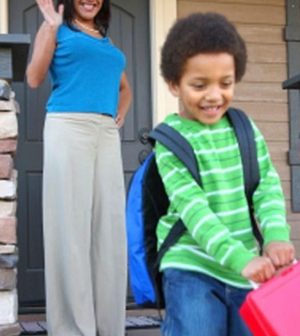- Navigating Your Midlife Crisis: Embracing New Possibilities
- City Raccoons Showing Signs of Domestication
- Mapping the Exposome: Science Broadens Focus to Environmental Disease Triggers
- One Week Less on Social Media Linked to Better Mental Health
- Your Brain Changes in Stages as You Age, Study Finds
- Some Suicide Victims Show No Typical Warning Signs, Study Finds
- ByHeart Formula Faces Lawsuits After Babies Sickened With Botulism
- Switch to Vegan Diet Could Cut Your Greenhouse Gas Emissions in Half
- Regular Bedtime Does Wonders for Blood Pressure
- Dining Alone Could Mean Worse Nutrition for Seniors
Vaccinated Teachers, Students Can Skip Masks This Fall: CDC

When schools open their doors this fall, teachers and students who are vaccinated can enter without masks, according to a new guidance issued Friday by the U.S. Centers for Disease Control and Prevention.
The relaxed recommendation comes as a national vaccination campaign in which children as young as 12 can get COVID-19 shots unfolds, accompanied by a general decline in coronavirus hospitalizations and deaths.
“We’re at a new point in the pandemic that we’re all really excited about,” and so it’s time to update the guidance, Erin Sauber-Schatz, who leads the CDC task force that prepares such recommendations, told the Associated Press.
Becky Pringle, president of the National Education Association, called the new CDC guidance “an important road map for reducing the risk of COVID-19 in schools.”
And American Federation of Teachers President Randi Weingarten praised the guidance as being “grounded in both science and common sense.
“Our ultimate goal remains: to get students, teachers and staff back in school buildings full time, and to make sure they’re safe while doing it,” Weingarten said in a statement, adding that dozens of the union’s affiliates are already holding vaccine clinics, the AP reported.
The CDC is not advising schools to require shots for teachers and vaccine-eligible kids. Also, the agency is not offering guidance on how teachers can know which students are vaccinated or how parents will know which teachers are immunized, the AP said.
That’s probably going to make for some challenging school environments, said Elizabeth Stuart, a John Hopkins University public health professor who has children in elementary and middle schools.
“It would be a very weird dynamic, socially, to have some kids wearing masks and some not. And tracking that? Teachers shouldn’t need to be keeping track of which kids should have masks on,” she told the AP.
Another potential obstacle: Schools should continue to space kids — and their desks — 3 feet apart in classrooms, the new CDC guidance says. But the agency stressed that spacing should not be an obstacle to getting kids back in schools. And it said distancing is not required among fully vaccinated students or staff.
All of this may prove tricky to execute, which is why the CDC is advising schools to make decisions that make the most sense, Sauber-Schatz said.
The biggest issues will be at middle schools where some students are eligible for shots and others aren’t. If sorting vaccinated and unvaccinated students proves too burdensome, administrators might choose to just keep a masking policy in place for everyone.
“The guidance is really written to allow flexibility at the local level,” Sauber-Schatz told the AP.
Widespread mask-wearing is expected to continue this fall in some of the nation’s largest school districts: In Detroit, everyone will be required to wear a mask unless everyone in the classroom has been vaccinated, the AP reported. But masks won’t be mandated in Houston schools. Philadelphia was planning to require masks, but on Friday a spokesperson said the school district is now reviewing their policy based on the CDC guidance, the AP said.
The CDC said long months of virtual learning have harmed many students and that such wide variations in infections and vaccination rates across the country makes a one-size-fits-all approach impossible.
“We know that in-person learning is really important for school, for children, for their educational, social and emotional well-being, and so we really want to get kids back in the classroom,” Sauber-Schatz told The New York Times.
As well as being difficult for students, virtual learning has meant many working parents stayed home to look after their children, and fully reopening schools is viewed as a major step in the country’s economic recovery.
“This a big moment,” said former acting CDC Director Dr. Richard Besser.
“It’s also a recognition that there are real costs to keeping children at home, to keeping them out of school, that school is so important in terms of children’s socialization and development and it provides other supports as well,” including to working parents, Besser told the Times.
More information
Visit the U.S. Centers for Disease Control and Prevention for more on school reopenings.
Source: HealthDay
Copyright © 2025 HealthDay. All rights reserved.










